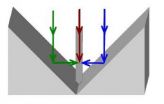(Press-News.org) The Who asked "who are you?" but Dartmouth neurobiologist Jeffrey Taube asks "where are you?" and "where are you going?" Taube is not asking philosophical or theological questions. Rather, he is investigating nerve cells in the brain that function in establishing one's location and direction.
Taube, a professor in the Department of Psychological and Brain Sciences, is using microelectrodes to record the activity of cells in a rat's brain that make possible spatial navigation—how the rat gets from one place to another—from "here" to "there." But before embarking to go "there," you must first define "here."
Survival Value
"Knowing what direction you are facing, where you are, and how to navigate are really fundamental to your survival," says Taube. "For any animal that is preyed upon, you'd better know where your hole in the ground is and how you are going to get there quickly. And you also need to know direction and location to find food resources, water resources, and the like."
Not only is this information fundamental to your survival, but knowing your spatial orientation at a given moment is important in other ways, as well. Taube points out that it is a sense or skill that you tend to take for granted, which you subconsciously keep track of. "It only comes to your attention when something goes wrong, like when you look for your car at the end of the day and you can't find it in the parking lot," says Taube.
Perhaps this is a momentary lapse, a minor navigational error, but it might also be the result of brain damage due to trauma or a stroke, or it might even be attributable to the onset of a disease such as Alzheimer's. Understanding the process of spatial navigation and knowing its relevant areas in the brain may be crucial to dealing with such situations.
The Cells Themselves
One critical component involved in this process is the set of neurons called "head direction cells." These cells act like a compass based on the direction your head is facing. They are located in the thalamus, a structure that sits on top of the brainstem, near the center of the brain.
He is also studying neurons he calls "place cells." These cells work to establish your location relative to some landmarks or cues in the environment. The place cells are found in the hippocampus, part of the brain's temporal lobe. They fire based not on the direction you are facing, but on where you are located.
Studies were conducted using implanted microelectrodes that enabled the monitoring of electrical activity as these different cell types fired.
Taube explains that the two populations—the head direction cells and the place cells—talk to one another. "They put that information together to give you an overall sense of 'here,' location wise and direction wise," he says. "That is the first ingredient for being able to ask the question, how am I going to get to 'point B' if I am at 'point A.' It is the starting point on the cognitive map."
The Latest Research
Taube and Stephane Valerio, his postdoctoral associate for the last four years, have just published a paper in the journal Nature Neuroscience, highlighting the head direction cells. Valerio has since returned to the Université Bordeaux in France.
The studies described in Nature Neuroscience discuss the responses of the spatial navigation system when an animal makes an error and arrives at a destination other than the one targeted —its home refuge, in this case. The authors describe two error-correction processes that may be called into play—resetting and remapping—differentiating them based on the size of error the animal makes when performing the task.
When the animal makes a small error and misses the target by a little, the cells will reset to their original setting, fixing on landmarks it can identify in its landscape. "We concluded that this was an active behavioral correction process, an adjustment in performance," Taube says. However, if the animal becomes disoriented and makes a large error in its quest for home, it will construct an entirely new cognitive map with a permanent shift in the directional firing pattern of the head direction cells." This is the "remapping."
Taube acknowledges that others have talked about remapping and resetting, but they have always regarded them as if they were the same process. "What we are trying to argue in this paper is that they are really two different, separate brain processes, and we demonstrated it empirically," he says. "To continue to study spatial navigation, in particular how you correct for errors, you have to distinguish between these two qualitatively different responses."
Taube says other investigators will use this distinction as a basis for further studies, particularly in understanding how people correct their orientation when making navigational errors.
INFORMATION:
Dartmouth researchers explore how the brain perceives direction and location
2012-10-20
ELSE PRESS RELEASES FROM THIS DATE:
NASA sees extra-large, now extra-tropical storm Prapiroon fading
2012-10-20
Prapiroon is both extra-large and now extra-tropical in the western North Pacific Ocean. NASA's Terra satellite captured an image of the large storm after Prapiroon became extra-tropical.
The Moderate Resolution Imaging Spectroradiometer (MODIS) instrument aboard NASA's Terra satellite captured a visible image of Extra-tropical Storm Prapiroon on Oct. 19 at 01:15 UTC (Oct. 18, 9:15 p.m. EDT). The storm appeared on the MODIS image to be as large as the main island of Japan and the strongest thunderstorms and heaviest rainfall appeared north of the center of circulation ...
Astronomers uncover a surprising trend in galaxy evolution
2012-10-20
VIDEO:
A study of 544 star-forming galaxies observed by the Keck and Hubble telescopes shows that disk galaxies like our own Milky Way unexpectedly reached their current state long after much...
Click here for more information.
A comprehensive study of hundreds of galaxies observed by the Keck telescopes in Hawaii and NASA's Hubble Space Telescope has revealed an unexpected pattern of change that extends back 8 billion years, or more than half the age of the universe.
"Astronomers ...
Cholera discovery could revolutionize antibiotic delivery
2012-10-20
Contact:
Lisa Craig (Burnaby resident), 778.782.7140, licraig@sfu.ca
Carol Thorbes, PAMR, 778.782.3035, cthorbes@sfu.ca
Photos on Flickr: http://at.sfu.ca/lutURE END ...
RIT professor studies connection between child, mother mortality
2012-10-20
The death of a child is a tragic event for a family, bringing with it feelings of numbness, anger, guilt and denial. And, unfortunately, for many families, the loss becomes too much to bear.
A new study co-conducted by a researcher at Rochester Institute of Technology uncovers the strong connection between the death of a child and the mortality of the mother, regardless of cause of death, gender of the child, marital status, family size, income or education level of the mother.
Javier Espinosa, assistant professor in RIT's College of Liberal Arts and an expert in health ...
Geosphere explores the Sierra Nevada, Colorado River system, Laurentia, and the deep sea
2012-10-20
Boulder, Colo., USA – Geosphere, The Geological Society of America's peer-reviewed online journal, has added papers to four special issues: Origin and Evolution of the Sierra Nevada and Walker Lane; CRevolution 2: Origin and Evolution of the Colorado River System II; Exploring the Deep Sea and Beyond; and Making the Southern Margin of Laurentia. Geosphere specializes in accommodating animations, sound, and movie files, along with high-resolution figures.
Abstracts for these and other Geosphere papers are available at http://geosphere.gsapubs.org/. Representatives of the ...
A novel scheme to enhance local electric fields around metal nanostructures
2012-10-20
Enhanced local electric fields are predominant in nonlinear optical properties, particularly in surface-enhanced Raman scattering (SERS), which is a sensitive technique used for the detection of trace amounts of chemicals. Analysis of the electric fields around nanostructures indicates that they can provide a basic foundation to obtain greater SERS intensity. Professor ZHANG Zhongyue and his group from the College of Physics and Information Technology at Shaanxi Normal University have proposed a novel scheme to enhance the local electric fields around nanostructures. The ...
AAP president Dr. Robert Block reflects on changes in pediatric health
2012-10-20
NEW ORLEANS – Robert Block, MD, FAAP, outgoing president of the American Academy of Pediatrics (AAP), will address attendees at the AAP National Conference & Exhibition Saturday, Oct. 20, at 10:40 a.m. during the opening plenary session at the Ernest N. Morial Convention Center in New Orleans. Dr. Block will lead a discussion on the "soul of a pediatrician," and how a pediatrician's devotion and compassion for children must persist as the world of medicine changes around us.
Dr. Block will also focus on his yearlong theme of "all adults were once children," to promote ...
American Academy of Pediatrics study documents early puberty onset in boys
2012-10-20
NEW ORLEANS -- A study conducted by the American Academy of Pediatrics (AAP) has documented that boys in the U.S. are experiencing the onset of puberty six months to two years earlier than reported in previous research.
The study, "Secondary Sexual Characteristics in Boys: Data from the Pediatric Research in Office Settings Network," will be published in the November 2012 Pediatrics and published online Oct. 20 to coincide with the AAP National Conference & Exhibition in New Orleans.
The trend toward earlier onset of puberty in girls is now generally accepted and supported ...
Cyberbullying only rarely the sole factor identified in teen suicides
2012-10-20
NEW ORLEANS – Cyberbullying – the use of the Internet, phones or other technologies to repeatedly harass or mistreat peers – is often linked with teen suicide in media reports. However, new research presented on Saturday, Oct. 20, at the American Academy of Pediatrics (AAP) National Conference and Exhibition in New Orleans, shows that the reality is more complex. Most teen suicide victims are bullied both online and in school, and many suicide victims also suffer from depression.
For the abstract, "Cyberbullying and Suicide: A Retrospective Analysis of 41 Cases," researchers ...
In vitro fertilization linked to increase risk for birth defects
2012-10-20
NEW ORLEANS – In vitro fertilization (IVF) may significantly increase the risk of birth defects, particularly those of the eye, heart, reproductive organs and urinary systems, according to new research presented Saturday, Oct. 20, at the American Academy of Pediatrics (AAP) National Conference and Exhibition in New Orleans.
According to the study, despite increasing use of IVF in the United States, associations between birth defects and IVF are poorly understood. Management of birth defects comprises a large part of pediatric surgical care and demands significant health ...


